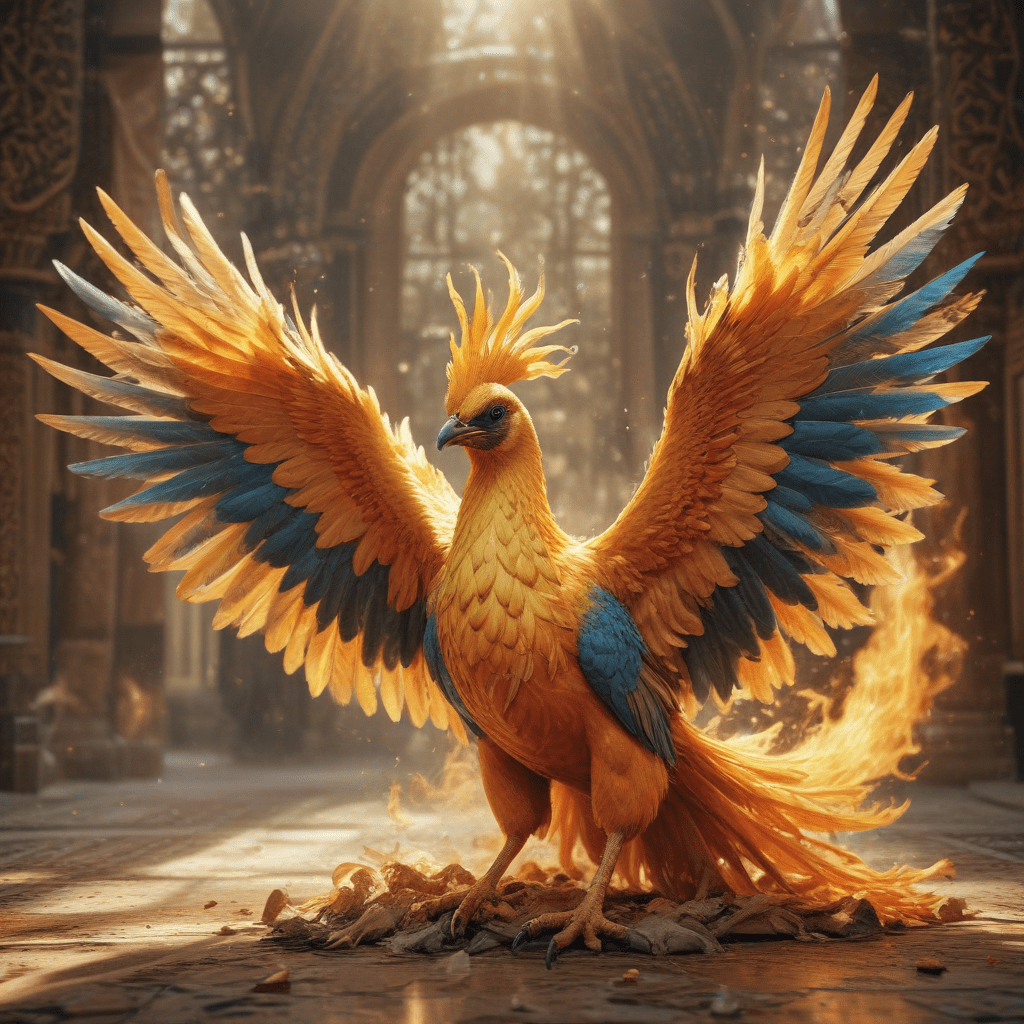The Mythical Birds of Persian Folklore
1. The Simurgh: The Benevolent King of Birds
The Simurgh, a majestic creature with the head of a dog, the body of a lion, and the wings of an eagle, is a prominent figure in Persian mythology. Often referred to as the "King of Birds," the Simurgh embodies wisdom, knowledge, and benevolence. Its feathers possess healing powers, and its tears can bring the dead back to life. The Simurgh resides on the mythical Mount Qaf, the highest point on Earth, overlooking all creation.
In the epic poem "Shahnameh," the Simurgh plays a pivotal role in the life of the legendary hero Rostam. When Rostam's infant son, Sohrab, is abandoned in the desert, the Simurgh takes pity on him and raises him as her own. Years later, Sohrab and Rostam unknowingly clash in battle, leading to a tragic confrontation where father slays son. The heartbroken Simurgh heals Rostam's wounds and provides guidance, illustrating her compassion and wisdom.
The Simurgh's symbolic significance extends beyond the realm of mythology. In Sufi mysticism, the Simurgh represents the divine essence, the ultimate goal of spiritual seekers. Its inaccessibility on Mount Qaf alludes to the difficulty of attaining enlightenment, while its healing powers symbolize the transformative nature of the spiritual journey.
2. The Huma: Symbol of Felicity and Good Fortune
In Persian folklore, the Huma is a mythical bird associated with auspiciousness and good fortune. Legend has it that the Huma's shadow brings happiness and prosperity to anyone it falls upon. Its feathers are said to possess magical properties, capable of healing the sick and granting wishes.
The Huma is depicted as a radiant bird, often described as a phoenix or a peacock, with magnificent plumage that shimmers with iridescent colors. Its rarity adds to its mystique, as sightings of the Huma are considered extremely fortunate. In Persian literature and art, the Huma is a recurring motif, symbolizing hope, joy, and divine blessings.
The Huma's association with good fortune has made it a popular symbol in Persian culture. Its image adorns talismans, amulets, and decorative objects, believed to bring luck and protection to their owners. The Huma also features prominently in Persian poetry, where it is invoked as a symbol of hope and aspiration.
3. The Anka: The Firebird of Persian Legend
The Anka, also known as the Simurgh or Phoenix, is a mythical firebird prominent in Persian mythology and literature. It is said to possess immense power and longevity, living for thousands of years before bursting into flames and being reborn from its ashes. The Anka is associated with fire, renewal, and immortality.
In the "Shahnameh," the Anka plays a significant role in the story of Zal, the son of Rostam. Abandoned at birth due to his unusual white hair, Zal is rescued and raised by the Anka in its巢穴on Mount Alborz. The Anka teaches Zal wisdom and instills in him a sense of purpose. When Zal eventually reunites with his father, he brings with him the blessings and guidance of the Anka.
The Anka's symbolism extends beyond its mythical origins. It represents the cyclical nature of life, death, and rebirth, as well as the transformative power of fire. In Sufi mysticism, the Anka symbolizes the human soul's journey towards enlightenment, undergoing purification through trials and tribulations before achieving spiritual rebirth.
4. The Kak: The Wise and Talkative Parrot
In Persian folklore, the Kak is a talking parrot known for its wisdom, wit, and ability to mimic human speech. It is often portrayed as a companion to wise men and scholars, offering insights and advice through its clever remarks. The Kak's intelligence and eloquence make it a popular character in Persian literature and民间故事。
In the story of "The Parrot of the Seven Colors," a parrot recounts the tale of seven different kings, each representing a different aspect of human life. The parrot's wisdom and ability to observe and learn from human experience make it a valuable source of knowledge and understanding.
The Kak's talkative nature also adds to its charm. It is often depicted as a humorous and entertaining companion, capable of engaging in witty banter and providing amusement. The Kak's ability to communicate with humans makes it a relatable and engaging figure in Persian folklore.
5. The Homa: The Bringer of Victory and Prosperity
In Persian mythology, the Homa is a mythical bird associated with victory, prosperity, and royal authority. It is often depicted as a majestic bird, resembling an eagle or a falcon, with golden plumage and a radiant aura. The Homa is said to bring good luck and success to those it favors.
The Homa plays a significant role in the investiture of Persian monarchs. The image of the Homa adorned royal crowns, scepters, and other symbols of power, representing the king's divine right to rule and his ability to bring prosperity to his subjects. The Homa's association with victory is also evident in its use as a military emblem, inspiring soldiers with its promise of triumph.
The Homa's symbolic meaning extends beyond the political realm. In Persian literature, the Homa represents hope, aspiration, and the pursuit of excellence. Its association with the sun and its golden plumage symbolizes enlightenment, knowledge, and divine guidance.
6. The Shaheen: The Legendary Eagle of Persia
The Shaheen, a majestic eagle revered in Persian folklore, is a symbol of strength, power, and royal authority. Often depicted with a golden plumage and piercing gaze, the Shaheen embodies the ideals of courage, determination, and leadership.
In Persian literature and poetry, the Shaheen is frequently associated with heroes and warriors. Its soaring flight and sharp vision represent the ability to overcome challenges, conquer enemies, and achieve victory. The Shaheen's image adorns royal emblems and insignia, signifying the king's power and authority to protect his subjects and uphold justice.
The Shaheen's symbolism extends beyond the realm of mythology and literature. In Persian culture, the Shaheen is considered a national symbol, representing the country's pride, independence, and resilience. Its image is often used in national emblems and sports teams, inspiring a sense of patriotism and national unity.
7. The Simorgh: The Divine and Benevolent Protector
In Persian mythology, the Simorgh holds a revered position as a divine and benevolent protector. Its majestic form, embodying the qualities of a bird, a lion, and a dog, symbolizes wisdom, strength, and compassion. The Simorgh resides on the mythical Mount Qaf, overseeing all creation with its watchful gaze.
The Simorgh plays a pivotal role in the epic poem "Shahnameh," guiding and protecting the legendary hero Rostam throughout his life. In times of adversity, the Simorgh offers guidance, healing, and unwavering support, demonstrating its unwavering commitment to the well-being of those under its care.
The Simorgh's benevolent nature extends beyond the realm of mythology. In Persian culture, the Simorgh is revered as a symbol of hope, protection, and divine intervention. Its image is often used as a talisman or amulet, believed to ward off evil spirits and bring good fortune. The Simorgh's compassionate nature and unwavering support inspire a sense of trust and security in those who seek its guidance.
8. The Manouchehr: The Talking Myna Bird of Wisdom
In Persian folklore, the Manouchehr is a talking myna bird renowned for its wisdom, wit, and ability to solve complex problems. Its intelligence and eloquence make it a valued advisor to kings and wise men, offering insights and solutions through its insightful remarks.
The Manouchehr's wisdom is demonstrated in the story of "The Talking Myna," where the bird helps a young prince solve a series of riddles to win the hand of a beautiful princess. The Manouchehr's ability to think critically, analyze situations, and provide effective solutions makes it an invaluable asset in times of need.
The Manouchehr's talking ability adds to its charm and mystique. Its ability to engage in witty banter, provide humorous commentary, and offer insightful observations makes it an entertaining and engaging companion. The Manouchehr's wisdom and wit have earned it a place as a beloved character in Persian folklore, admired for its intelligence, humor, and problem-solving abilities.
9. The Simorgh and Zal: A Myth of Love and Sacrifice
The tale of the Simorgh and Zal is a poignant and enduring myth in Persian folklore, exploring themes of love, sacrifice, and the transformative power of compassion. The story recounts the abandonment of Zal, a newborn with white hair, and his subsequent upbringing by the Simorgh, a mythical bird symbolizing wisdom and benevolence.
The Simorgh's decision to raise Zal as her own demonstrates her unwavering compassion and acceptance of those who are different. Her nurturing care and guidance allow Zal to grow into a wise and courageous young man, despite the challenges he faces due to his unusual appearance.
The myth of the Simorgh and Zal highlights the importance of love, acceptance, and the transformative power of compassion. It emphasizes that true beauty lies within one's character and that outward appearances should not dictate one's worth. The Simorgh's selfless act of love and sacrifice inspires us to embrace those who are different and to see beyond the surface to recognize the true potential within each individual.
10. The Simurgh in Sufi Mysticism: An Allegory for the Divine
In Sufi mysticism, the Simurgh is revered as an allegory for the divine essence, representing the ultimate goal of spiritual seekers. Its inaccessibility on Mount Qaf symbolizes the difficulty of attaining enlightenment, while its healing powers symbolize the transformative nature of the spiritual journey.
The Simurgh's journey to Mount Qaf represents the soul's arduous quest for union with the divine. The trials and tribulations faced by the Simurgh and its companions represent the challenges and obstacles that spiritual seekers must overcome on their path to enlightenment.
The Simurgh's eventual arrival at Mount Qaf and its transformation into a single, perfect being symbolizes the ultimate realization of the divine. The annihilation of the individual self and the attainment of unity with the divine represent the culmination of the spiritual journey, a state of perfect bliss and enlightenment.
Frequently Asked Questions (FAQs)
1. What are the most famous mythical birds in Persian folklore?
The Simurgh, the Huma, the Anka, the Kak, the Homa, the Shaheen, the Simorgh, the Manouchehr, and the Simorgh and Zal are among the most renowned mythical birds in Persian folklore.
2. What are the symbolic meanings of these birds?
These birds represent various concepts, including wisdom, knowledge, benevolence, auspiciousness, good fortune, fire, renewal, immortality, intelligence, wit, victory, prosperity, strength, power, royal authority, divine protection, love, sacrifice, and the divine essence.
3. How are these birds depicted in Persian literature and art?
These birds are often portrayed as majestic creatures with unique features and radiant plumage. Their images adorn manuscripts, paintings, sculptures, and other artistic expressions, reflecting their cultural significance and symbolic value.
4. What are some of the popular stories and myths associated with these birds?
The epic poem "Shahnameh" features tales of the Simurgh, the Anka, and the Simorgh and Zal. Other stories and myths explore the symbolism and significance of these birds in Persian culture and folklore.
5. What is the cultural significance of these birds in Persian society?
These birds hold a revered position in Persian culture, representing various ideals, values, and beliefs. Their images and stories continue to inspire and captivate generations, reflecting the rich heritage and enduring legacy of Persian folklore.




